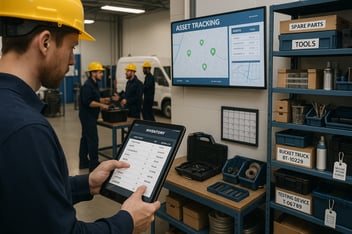
Misplaced tools. Missing inventory. Delayed dispatch. When you can't track your assets, your entire operation feels it—from wasted technician time to inflated replacement costs. Whether you're managing telecom builds, utility networks, or oil and gas infrastructure, you need to know what you own, where it is, and how it's being used.
That’s where asset tracking comes in. This guide breaks down how asset tracking works, why it matters, and what to look for in a system that keeps your field operations running efficiently.
What Is Asset Tracking?
Asset tracking is the process of monitoring the location, condition, and usage of physical assets—such as machinery, tools, fleet vehicles, or communications infrastructure—throughout their lifecycle.
In practice, asset tracking means monitoring and managing physical assets like tools, vehicles, equipment, and inventory using methods such as barcodes, RFID tags, GPS, and Bluetooth Low Energy (BLE) beacons. Businesses rely on it for equipment monitoring, theft prevention, and lifecycle management to cut costs and improve efficiency.
Field teams use this process to answer critical questions:
-
Where is this piece of equipment right now?
-
Has it been inspected or maintained recently?
-
Is it being used effectively—or sitting idle?
Unlike inventory, which tends to involve consumables or stock, asset tracking focuses on higher-value items that require maintenance, depreciation, or compliance documentation. This distinction is important for industries that need chain-of-custody tracking, theft prevention, and insurance compliance.
Why Asset Tracking Matters in the Field
When equipment is unaccounted for, projects stall. Teams waste time searching for the right tool or even tracking assets location. Safety checks get missed. Or worse, capital equipment disappears.
Here’s what our customers tell us they’ve experienced:
-
Missed SLAs because the right asset wasn’t on site
-
Higher operational costs due to duplicate rentals or replacements
-
Downtime caused by unplanned failures and missed inspections
-
Compliance issues when audits don’t match physical reality
Without asset tracking, companies often face risks such as inaccurate inventory counts, costly delays, and exposure to theft or loss. In industries like utilities or healthcare, the consequences can also include regulatory fines or safety violations.
In oil & gas asset tracking, teams monitor critical equipment like compressors, valves, and pipeline sensors spread across remote sites. Because the sector is heavily regulated, keeping accurate digital records of asset inspections and movements helps operators avoid downtime, environmental penalties, and safety risks.
And the data backs it up. According to a July 2024 Gartner study, 41% of organizations still rely on manual methods and 26% use spreadsheets to manage asset operations, creating delays and blind spots that can seriously impact ROI (Gartner).
This is why many organizations turn to integrated asset management solutions that unify asset tracking, work orders, and reporting into one system.
What Is an Asset Tracker?
An asset tracker is a tool—typically hardware, software, or both—that enables teams to monitor and manage physical equipment.
There are several types of ways to track assets:
-
GPS tracking devices for fleet and large mobile equipment
-
Barcode or QR code labels for tools and smaller field assets
-
RFID tags for high-volume asset movement, especially in warehouses or fleet operations
-
IoT sensors for condition-based monitoring, providing predictive maintenance alerts
Combined with a platform or mobile app, these tools feed real-time data to operations teams, giving them visibility over usage, movement, and health.
Some even use Bluetooth Low Energy (BLE) for close-range tracking of tools, pallets, or parts across warehouses and job sites.
Key Features of an Effective Asset Tracking System
When teams look for a better way to manage assets, they often ask for:
-
Real-time location tracking across job sites, vehicles, and yards
-
Maintenance alerts based on time, usage, or condition
-
Mobile scanning using barcodes or QR codes for check-in/out
-
Offline functionality for areas with limited signal
-
Integration with scheduling, inventory, and fleet management systems
-
Theft prevention alerts that notify teams when equipment is moved without authorization
-
Analytics and reporting dashboards that turn raw asset data into actionable insights
A strong tracking asset system brings these features into one place, giving field technicians, operations leads, and warehouse managers a shared source of truth.
Many customers adopt field asset management software to ensure everything is tracked from deployment to retirement.
Asset Tracking vs Inventory Management
It’s easy to confuse asset tracking with inventory management, especially when both involve physical items. But the distinction matters.
| Type | Inventory Management | Asset Tracking and Management |
|---|---|---|
| Purpose | Manage consumables and parts | Track valuable equipment and tools |
| Lifecycle | Replenished and used | Maintained, depreciated, and reassigned |
| Example Items | Cable, routers, bolts | Compressors, trucks, meters |
| Tracking Focus | Quantity and reorder thresholds | Location, status, and usage |
| Responsibility | Often warehouse or procurement team | Often operations, compliance, or fleet teams |
Trends Driving the Need for Automated Asset Tracking
As industries digitize their operations, asset visibility is becoming a top priority. According to Markets and Markets, the global enterprise asset management market is projected to reach $42.2 billion by 2027, driven by growing adoption of IoT, predictive maintenance, and cloud solutions (source).
Field leaders aren’t just tracking assets—they’re using asset data to improve decisions and reduce downtime. That’s why more teams are shifting to automated asset tracking systems that offer real-time insights across devices.
Automated asset tracking uses IoT sensors, barcodes, and integrated workflows to update asset locations and status without human input. Instead of chasing paperwork, operations managers receive real-time dashboards and alerts, improving productivity while reducing costs.
Incorporating GPS fleet tracking, BLE beacons for indoor environments, and RFID for warehouse assets ensures organizations cover both wide geographies and close-range environments.
How to Track Assets in the Real World
We’ve seen successful tracking strategies that include:
-
Assigning barcodes to all equipment—scanned during deployment and return
-
Outfitting high-value items with GPS devices to monitor movement
-
Scheduling maintenance based on runtime or wear conditions
-
Creating asset profiles with status, photos, documentation, and logs
-
Using mobile apps and enabled devices to check assets in and out directly from the field
- Deploying BLE or RFID tags to simplify large-scale warehouse audits
Some teams also integrate GIS asset tracking to tie equipment data to geographic coordinates, letting them visualize where every asset is located on a digital map. For utilities, telecom, and oil and gas, this means being able to plan work against terrain, easements, or network layouts, aligning with fleet management for vehicles and crew. Ultimately this improves both field efficiency and compliance reporting.
Paired with a field data collection application, technicians can record information directly from mobile devices, even in offline or low-connectivity environments. Photos, digital signatures, and inspection logs sync back to central systems once online, ensuring managers always have accurate, audit-ready data.
With the right process in place, even distributed teams can manage thousands of assets with confidence.
If you're unsure where to start, platforms like Field Squared are built to help businesses implement scalable asset tracking without disrupting their day-to-day work.
Final Thoughts: Get Control Over What You Own
Tracking assets used to be a back-office concern. Today, it’s a field priority. When equipment is out of sight, it’s also out of control. That’s why teams are investing in smarter tools to help them gain clarity and take action.
Whether your goal is to eliminate waste, improve technician efficiency, or ensure compliance, the right asset tracking and monitoring system makes a measurable difference. From theft prevention to optimized resource use, companies see clear ROI when they modernize.
Because when you know where everything is—and what condition it’s in—your business can move faster, work smarter, and avoid the hidden costs of poor visibility.



